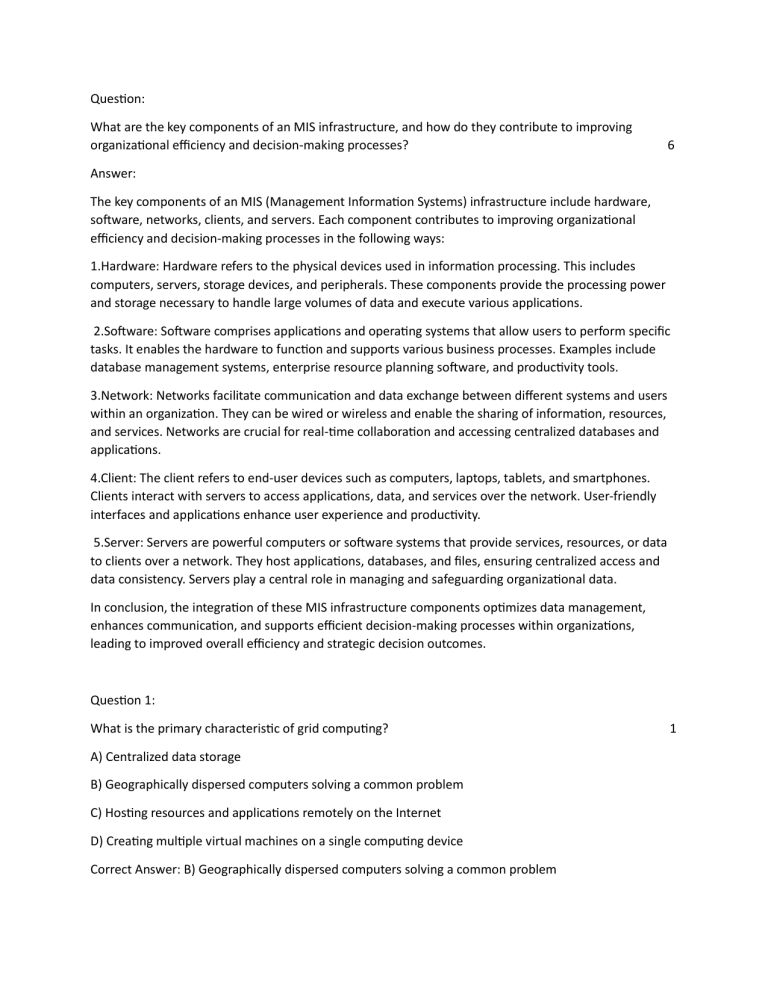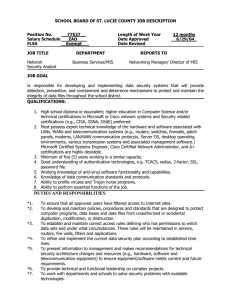
Question: What are the key components of an MIS infrastructure, and how do they contribute to improving organizational efficiency and decision-making processes? 6 Answer: The key components of an MIS (Management Information Systems) infrastructure include hardware, software, networks, clients, and servers. Each component contributes to improving organizational efficiency and decision-making processes in the following ways: 1.Hardware: Hardware refers to the physical devices used in information processing. This includes computers, servers, storage devices, and peripherals. These components provide the processing power and storage necessary to handle large volumes of data and execute various applications. 2.Software: Software comprises applications and operating systems that allow users to perform specific tasks. It enables the hardware to function and supports various business processes. Examples include database management systems, enterprise resource planning software, and productivity tools. 3.Network: Networks facilitate communication and data exchange between different systems and users within an organization. They can be wired or wireless and enable the sharing of information, resources, and services. Networks are crucial for real-time collaboration and accessing centralized databases and applications. 4.Client: The client refers to end-user devices such as computers, laptops, tablets, and smartphones. Clients interact with servers to access applications, data, and services over the network. User-friendly interfaces and applications enhance user experience and productivity. 5.Server: Servers are powerful computers or software systems that provide services, resources, or data to clients over a network. They host applications, databases, and files, ensuring centralized access and data consistency. Servers play a central role in managing and safeguarding organizational data. In conclusion, the integration of these MIS infrastructure components optimizes data management, enhances communication, and supports efficient decision-making processes within organizations, leading to improved overall efficiency and strategic decision outcomes. Question 1: What is the primary characteristic of grid computing? A) Centralized data storage B) Geographically dispersed computers solving a common problem C) Hosting resources and applications remotely on the Internet D) Creating multiple virtual machines on a single computing device Correct Answer: B) Geographically dispersed computers solving a common problem 1 Question 2: Which of the following refers to the use of resources and applications hosted remotely on the Internet?1 A) Grid computing B) Virtualized computing C) Cloud computing D) Infrastructure as a Service (IaaS) Correct Answer: C) Cloud computing Question 3: What is the purpose of a data center in the context of MIS infrastructure? 1 A) Hosting resources and applications remotely on the Internet B) Creating multiple virtual machines on a single computing device C) Reducing carbon emissions and floor space requirements D) Housing management information systems and associated components Correct Answer: D) Housing management information systems and associated components Question 4: Which type of computing reduces carbon emissions and floor space requirements? A) Virtualized computing B) Cloud computing C) Grid computing D) Infrastructure as a Service (IaaS) Correct Answer: A) Virtualized computing 1 Question 1: Explain the evolution of programming languages, from machine languages to high-level languages like Visual Basic. What advantages do high-level languages offer, and how have they simplified the process of software development? 3 Answer: The evolution of programming languages began with machine languages, represented by binary code. As technology advanced, assembly languages, which were more human-readable, were introduced. Thirdgeneration languages like FORTRAN and COBOL were designed to be more English-like, making programming more accessible. High-level languages like Visual Basic further abstracted complexity, offering advantages such as easier syntax, greater portability, and the ability to focus on problem-solving rather than hardware details. They simplified software development by providing extensive libraries, enabling rapid application development, and making coding more intuitive and efficient. Question 2: Describe the role of virtual reality (VR) in shaping modern business strategies. How is VR utilized for training, product design, customer engagement, and marketing? Provide examples of successful VR implementations in different industries. 3 Answer: Virtual reality (VR) plays a pivotal role in modern business strategies by offering immersive experiences. In training, VR simulations replicate real-life scenarios, enhancing employee skills. In product design, VR allows engineers and designers to visualize and modify prototypes in a virtual environment. For customer engagement, VR creates interactive and personalized experiences, fostering brand loyalty. In marketing, VR campaigns provide unique and memorable interactions, increasing customer engagement. Examples include VR training modules for medical professionals, VR-enhanced car design in automotive industries, VR-driven virtual tours in real estate, and VR-enabled interactive exhibitions in museums, all showcasing the diverse applications of VR in different sectors. Question 1: Which generation of programming languages is characterized as more English-like, focusing on the procedure of the application problem at hand? A) Machine Languages B) Procedural Languages C) Fourth Generation Languages (4GL) D) Object-Oriented Programming (OOP) Correct Answer: B) Procedural Languages 1 Question 2: What is the primary advantage of open-source operating systems like Linux? 1 A) They are proprietary, limiting the usage to specific applications. B) They are less secure due to the open nature of the source code. C) They encourage collaborative development and innovation. D) They are expensive, ensuring high-quality performance. Correct Answer: C) They encourage collaborative development and innovation. Question 3: In the context of virtual reality (VR), what does the term "immersive experiences" refer to? 1 A) VR software with limited features and basic interactions. B) VR environments that simulate real-world experiences, engaging multiple senses. C) VR hardware with advanced sensors and tracking capabilities. D) VR simulations used exclusively for entertainment purposes. Correct Answer: B) VR environments that simulate real-world experiences, engaging multiple senses. Question 4: When transitioning from custom-designed applications to packaged software solutions, what is a key consideration for businesses? A) The cost of custom-designed applications. B) Compatibility, scalability, and support of the packaged software. C) The availability of in-house developers for custom applications. D) The need for entirely new hardware infrastructure. Correct Answer: B) Compatibility, scalability, and support of the packaged software. 1



